
Effects of Horsetail, Alfalfa, Ortie, Chêne and Aleppo oak as Potential Hemostatic Agents on Laboratory Coagulation Tests

Abstract
This study investigated the effect of ethanol extracts of horsetail, alfalfa, ortie, chêne and aleppo oak on blood coagulation in vitro. Extraction was performed by the maceration method. Extracts were mixed with platelet and plasma, then prothrombin time (PT), activated partial thromboplastin time (APTT) and platelet aggregation tests were conducted. Alfalfa extract had a dose-dependent effect on the PT. Ortie, and horsetail, reduced the PT significantly compared to control group. Alfalfa, horsetail, and ortie reduced the APTT, but their effect was insignificant compared to the control group. The pooled extract showed the highest effect compared to the single extracts in a dose-dependent manner. Horsetail and alfalfa induced platelet aggregation in response to arachidonic acid but not in response to collagen. In the case of ortie, no aggregation occurred regarding the arachidonic acid, and incomplete was observed in response to collagen. Interestingly, blood clotting occurred immediately after adding the chêne, aleppo oak and the pooled extract, and therefore platelet poor plasma (PPP) and platelet rich plasma (PRP) became jelly. Generally, chêne and aleppo oak, as well as pooled extract, were more effective in inducing both primary and secondary coagulation pathways via shortening the PT and APTT, and induction of platelet aggregation.
Keywords:
Coagulation, Platelet aggregation, Horsetail, Ortie, Alfalfa, Chêne, Aleppo oakIntroduction
The World Health Organization (WHO) estimates that 85–65% of the world's population relies on traditional medicines to treat diseases.1,2 The effects of different plants have been studied in various studies.3 Most Herbal medicines are believed to have minimal side effects. They are increasingly being used in developing countries due to lower costs and fewer side effects than their chemical counterparts.4 Historically, plant extracts were applied for different purposes, such as preventing bleeding or treating wounds, and they are still common among indigenous and tribal populations. It was shown in the study of Chokpaisarn et al. that Quercus infectoria solution has been clinically proved to be of great potential as an alternative treatment for chronic ulcers in diabetes.5 It has been proven in various studies that some plants have blood pro-coagulatory characteristics, which result in platelet aggregation and also they can reduce clotting time, bleeding time, prothrombin time, activated partial thromboplastin time which are parameters affecting hemostasis.6
Different factors, such as surgery and trauma, can trigger hemorrhage in human beings. Severe hemorrhage can potentially cause substantial morbidity and mortality. Hemorrhage occurs if the vascular wall integrity gets disrupted. The extent of cellular injury and organ dysfunction secondary to hemorrhage is a complicated process dependent upon the duration and severity of bleeding and hypoperfusion. Some of these patients will require an allogeneic blood transfusion, which has its intrinsic risks, such as infectious disease transmission, allergic reactions, hemolytic reactions, and lung injury. There are pharmacological and non-pharmacological approaches to promote hemostasis.7,8
Techniques employed to promote hemostasis include surgical suture ligatures, cautery, chemical agents, self-assembling nanoparticles, and physical methods, like mechanical pressure. Topically-applied hemostatic agents have enormous clinical applications in achieving hemostasis.8
This is because conventional and topically-applied hemostatic agents pose minimal damage to the site, whereas other methods such as thermal ones can burn or necrosis the tissues and result in infection. Therefore, local hemostatic agents on the bleeding sites and wound dressings seem to be more appreciated.9 Owing to this fact, some medicinal plants are good candidates as hemostatic and blood coagulation agents.6
Ortie, (Urtica dioica L), is a perennial plant that belongs to the Urticaceae family.22 Ortie leaves possess a large number of biologically active compounds. The phytochemical compounds in ortie include flavonoids, lignans (low molecular weight polyphenols), fatty acids, sterols, polysaccharides, glycoproteins, carotenoids, plastocyanins, and lectins.10 It is commonly used to cure inflammation, rheumatoid arthritis, infectious wounds, internal bleeding, burns, and acne.11
The alfalfa plant (Medicago Sativa) is rich in minerals and vitamins, and the related precursors include vitamin K, iron, calcium, magnesium, phosphorus and carotene. The plant has been traditionally used to accelerate wound healing and reduce swelling.12 In traditional medicine, alfalfa is considered a blood supplement.13 Pharmacological studies have also shown that alfalfa helps prevent skin bleeding and accelerate blood coagulation.14,15,23
The Persian chêne – Quercus brantii – belongs to the Fagaceae family. The fruit of the chêne – acorn – is useful in the treatment of various haemorrhages, stomach ulcers and skin ulcers. It also has antibacterial properties.16 Glycosides, alkaloids, tannins, saponins, flavonoids, resins, terpenes, steroids, phenolic acids, proteins, fibre, minerals and vitamins B, C and A are the constituents of chêne.17
The aleppo oak (Quercus infectoria G.Olivier) is a spherical plant product that forms through insect holes and spawns on fresh chêne branches. This oak species is well known for producing galls (called manjakani in Malaysia, majuphal in India) that have been traditionally used for centuries in Asian medicine. The HPTLC analysis on aleppo oak extract showed 19.925% tannic acid and 8.75% gallic acid. This plant also contains flavonoids, steroids, carbohydrates, and phenolic and polyphenolic compounds.18,19
The horsetail (Equisetum arvense) is classified as fertile and infertile – the latter contains chlorophyll particles. The various parts of the plant contain silicic acid, oxalic acid, malic acid, a resinous substance and a saponin known as eco-acetine. The ashes of this plant contain more than 70% silica. It is claimed that the blood-cessation effect of this plant is related to the silica. Colloidal silica increases the elasticity and resistance of the skin. This plant is also helpful in treating internal wounds, which lead to blood clots in internal organs.21
Homeostasis prevents blood loss from healthy arteries and stops bleeding from damaged arteries.24 Hence, it is a dynamic process in which clot formation, anticoagulation and clot breakdown are in equilibrium.25 There are three main stages associated with homeostasis: vasoconstriction, as the primary stage; platelet plug formation, temporary homeostasis (primary homeostasis); and the third stage, fibrin clot formation (blood coagulation or secondary homeostasis), which occurs after primary homeostasis.25 Laboratory evaluation of the blood coagulation or secondary homeostasis was performed in tow way intrinsic and extrinsic pathways. Both pathways including some hemostatic factors in blood plasma. Results of the both pathways report in second. For the intrinsic pathway the prothrombin addition initiates the reaction (prothrombin is not exists in blood in normal situation so it’s come from out of blood), so time were spent from the prothrombin addition to fibrin activation (fibrin clot) report as prothrombin time (PT). On the other hand, evaluation of the intrinsic pathway performed by addition of ellagic acid activate contact factors in plasma. So, the time from addition of ellagic acid to fibrin activation report as activated partial thromboplastin time (APTT).
Various studies have examined the effects of various medicinal plants on the process of hemostasis and blood coagulation in vitro and in vivo. These studies yielded different and sometimes contradictory results.6 However, no detailed studies determine these plants' hemostatic or coagulation mechanisms to the best of our knowledge. Therefore, we evaluated the probable pro- or anti-coagulatory activity of above-mentioned plants by performing laboratory tests including, PT, APTT and platelet aggregometry.
Experimental
General experimental procedures – The alcoholic maceration method was applied for the preparation of chêne, aleppo oak, horsetail, alfalfa, and ortie extracts. Then, the dried extract was dissolved in phosphate-buffered saline (PBS), and concentrations of 50, 100 and 200 mg/mL were prepared accordingly. Blood samples were collected from healthy individuals without any underlying disorder or history of anticoagulant therapy. Subsequently, platelet Poor plasma (PPP) for PT and APTT, and platelet rich plasma (PRP) for aggregometry tests were prepared. PT and APTT tests are performed to investigate herbs’ effects on secondary coagulation. Additionally, aggregometry test is conducted to assess the impacts of herbs on primary coagulation and platelet aggregation.
Preparation of plant samples – Aerial parts (leaves, flowers and stems) of chêne, aleppo oak, horsetail, alfalfa and ortie plants were provided by the Pasture Institute of Iran. Afterwards, the plants were dried overnight in the fresh air and crushed by an electric grinder. The dried plants were then stored in a dry and dark environment.
Extraction – In order to perform extraction, 300 g of dried plant powder was added to 120 mL of 96% ethanol and placed on a rotator for 24 hours (Heidolph unimax 2010, Rotor, Keif, shaker Germany, Chwabach) at a speed of 90 rpm. The pulp was then removed from the extracts using a Watmann filter paper (Watmann 0.5 mm, USA, Samford) and Buchner funnel. The extract was filtered thoroughly under suction conditions using a vacuum pump, followed by the excess material removal. It was then concentrated under negative pressure at 40°C with a rotary evaporator (rotary evaporator, Heidolph WD 2000, Brinkmann, Canada). The alcoholic solvent was completely separated from the extract and then incubated at 30°C for 16 hours to dry the extract. The dried extracts were dissolved in 2 mL PBS solution. Extracts of 50, 100 and 200 mg/mL of dried extracts were prepared and stored in sterile containers with lids at 4°C until testing.26
Blood sample collection – The blood samples were taken from healthy individuals with no underlying disorder or history of anticoagulant therapy who had previously filled out the consent form. The blood samples collect in sodium citrate 3.2% as anticoagulant. they mixed in the ratio of 1:9 were 9 volume of blood mix with 1 volume of the sodium citrate. The PPP was obtained by centrifuging tubes (RST-1GS, Iran) at 4000 rpm for 5 minutes, and then supernatant plasma was collected. For more accuracy and limited the personality effect on the tests we used pool plasma from 10 peoples were contributing in our study.
Concentrations of 50, 100 and 200 mg/mL of extracts were initially used to obtain optimal conditions with a ratio of 2:5, 1:2 and 1:5 extracts to blood and incubation times of two, four and eight minutes. Since optimal results were attained, a ratio of 1:5 and an incubation time of four minutes were selected, and the following experiments were performed accordingly. Firstly, 100 μL of the extract was mixed with 500 μL of plasma in sterile microtubes and then placed at room temperature for four minutes. The PT and APTT tests were performed by a full automated coagulometer (Solea 100 biolab Germany) according to the manufacturer’s instruction (Thermo Ficher Scientific, Waltham, MA, USA).
Platelet aggregometry – In order to obtain PRP, blood samples were collected in sodium citrate anticoagulant collection tube. Then, centrifuged at 1000 rpm for 10 minutes, supernatant was collected as PRP. In this study, two agonists, including arachidonic acid and collagen at concentrations of 0.5 mmol and 5 μg/mL were used, respectively. According to the instructions, 100 μL of each extract at 200 mg/mL was first mixed with 500 μL of PRP at room temperature for four minutes. Agonists were then added sequentially, and the corresponding graphs were plotted using a Whole Blood/Optical Lumi Aggregometer (Model 700 CHRONO-LOG Havertown, USA). In the control group, PBS solution was used instead of the extract.
Statistical analysis – SPSS (SPSS Inc., IL, USA) was used for data analysis. One-way analysis of variance (ANOVA) test was used to compare the data between groups. Results were reported as mean ± standard deviation.
Results
In this study, we investigated the effect of plant extract in concentrations of 50, 100, and 200 mg/mL on the coagulation tests of PT, APTT and platelet aggregation separately. Also, a pooled extract of plants was prepared in three concentrations of 50, 100, and 200 mg/mL, where the plants extracts were combined in the same proportion, and the effect of the pooled extract on PT, APTT and platelet aggregation tests was investigated. Finally, the overall effect of single and combined extracts of these plants was evaluated on PT, APTT and platelet aggregation tests.
In this context, the effect of alfalfa extract on PT test, and the increase in extract concentration increased PT. The most significant decrease in PT was observed for 50 mg/mL compared to control (p = 0.020) (Fig. 1A). On the other hand, ortie, as well as horsetail was not dose-dependent. It’s reduced the PT significantly compared to control, without any significant difference between the three concentrations (p = <0.01) (Figs. 1b and 1C).
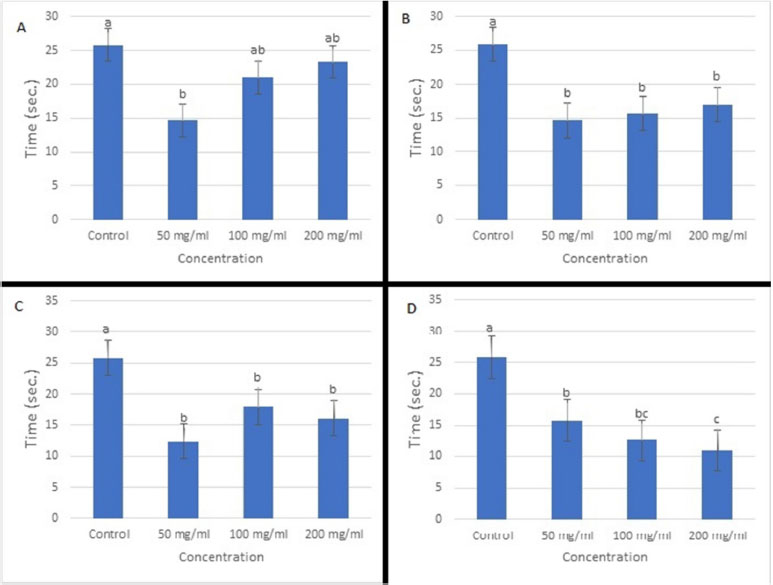
Effect of different concentrations of alfalfa (A); ortie (B); horsetail (C) and pooled extracts (D) on the PT test result; different letters in each column indicate a significant difference.
In the case of a mixture of five plants (pooled extracts), the PT result was lower than the control group at all three concentrations in a dose-dependent manner, having a more significant effect at a concentration of 200 mg/mL (p < 0.01) (Fig. 1D). According to the results, the pooled extract had the most significant effect on the PT test compared to the single extracts (Fig. 2).
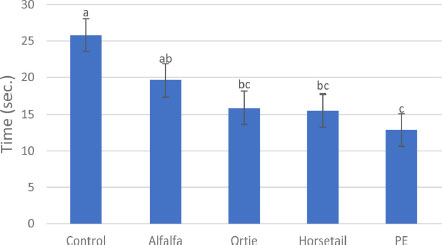
Comparison of the effect of different plant extracts at concentration of 50 mg/mL on the PT test result; different letters in each column indicate a significant difference.
An interesting event was observed in the case of chêne and aleppo oak. In this context, plasma became jelly immediately after adding the extracts (Fig. 3A).
The results showed that alfalfa, horsetail, and ortie (p = <0.01) reduced the APTT, but the effect of alfalfa and horsetail was not statistically significant compared to the control group (P > 0.05). (Figs. 4A, 4B and 4C). As observed for the PT test, the effect of the pooled extract was dose-dependent, having a more significant effect at a concentration of 200 mg/mL (p < 0.05) (Fig. 4D). The pooled extract was more effective than single extracts and significantly shortened the APTT (Fig. 5). As observed in the PT test, plasma became jelly immediately after adding the chêne and aleppo oak extracts. Therefore, it was not possible to perform the test (Fig. 3A).
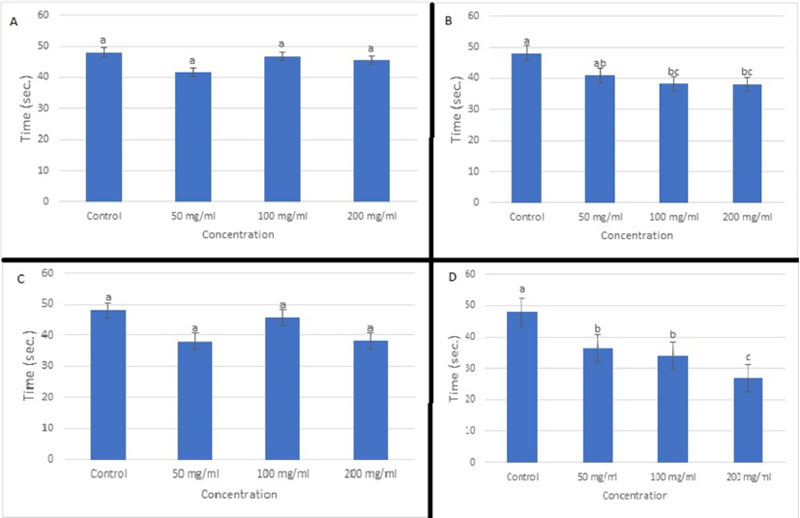
Effect of different concentrations of alfalfa (A); ortie (B); horsetail (C) and pooled extracts (D) on the APTT test result; different letters in each column indicate a significant difference.
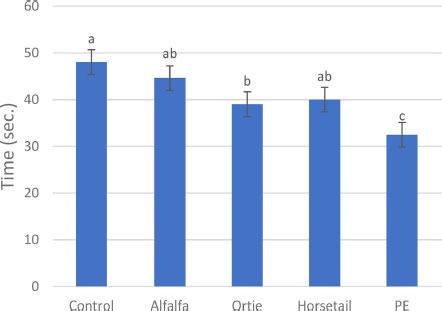
Comparison of the effect of different plant extracts at concentration of 50 mg/mL on the APTT test result; different letters in each column indicate a significant difference.
Platelet aggregation was assessed in the presence of different plant extracts in response to two common agonists, including collagen and arachidonic acid. According to the results, Arachidonic acid induced platelet aggregation strongly in the presence of horsetail extract (maximum aggregation 110%), but aggregation did not occur in response to collagen (Fig. 6B). In the case of ortie extract, no aggregation occurred regarding the arachidonic acid, and incomplete aggregation (maximum aggregation 24%) was observed in response to collagen (Fig. 6C). Furthermore, platelet aggregation was observed in the presence of alfalfa in response to arachidonic acid (maximum agitation 83%), but Collagen was unable to induce aggregation (Fig. 6D). Interestingly, platelet aggregation occurred immediately after adding the chêne, aleppo oak and pooled extract, and therefore PRP became jelly (Fig. 3).
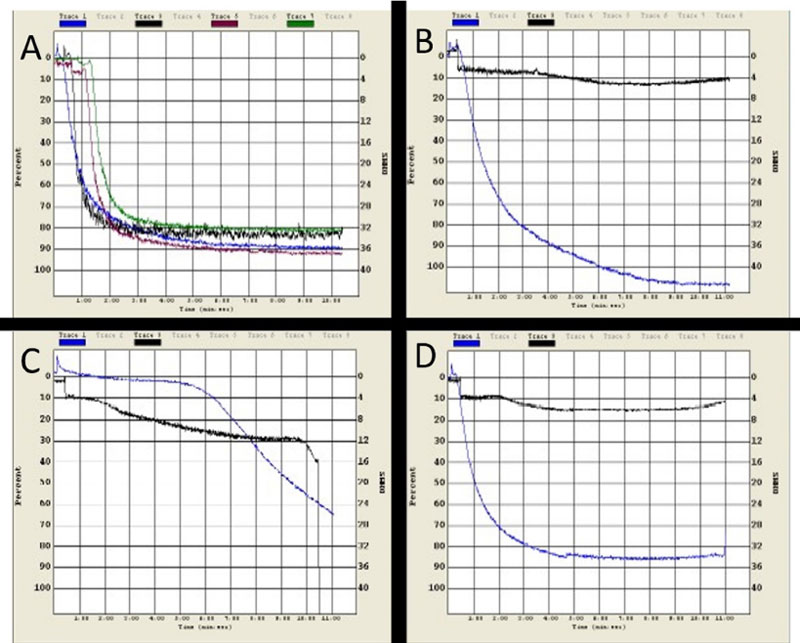
Platelet aggregation curve in the presence of the plant extracts against agonists, A; control (red and green) and arachidonic acid (blue and black). B; horsetail sample against collagen (black) and arachidonic acid (blue). C; ortie samples against collagen (black) and arachidonic acid (blue). D; alfalfa samples against collagen (black) and arachidonic acid (blue).
Discussion
Generally, stopping bleeding immediately in accidents and battlefields has always been of considerable importance. Hence, effective, cheap and portable products with no or minor side effects in decreasing the hemostasis time are the main challenges and concerns the relevant entities face.6,24,27,28 In the past, some specific herbs were used to treat wounds, infections, and to prevent bleeding based on their hemostatic, astringent, healing, and antiseptic properties6,27. In this study, medicinal plants were selected according to their hemostatic, astringent, antibacterial and healing characteristics.29-32 According to the results, all applied plants induced the coagulation process, particularly in the PT test. However, their effect was insignificant in higher concentrations. In contrast, pooled extracts had a dose-dependent effect, in which the increase of the concentration had shortened both PT and APTT. For example, alfalfa reduced PT just at 50 mg/mL concentration, but its effect at higher concentrations, as well as the APTT test result, was not significant.
The effect of horsetail and ortie was relatively similar, having a significant effect at all three concentrations on PT, but horsetail imposed an insignificant effect on the APTT test. The polled extract had an apparent pro-coagulatory effect on both PT and APTT tests, mainly because of the presence of chêne and aleppo oak. In the case of platelet aggregometry, horsetail and alfalfa induced platelet aggregation just in response to arachidonic acid, and therefore, aggregation was not observed in the presence of collagen. Furthermore, ortie could not induce aggregation, either in response to arachidonic acid or collagen. In the case of chêne and aleppo oak, as expected from previous studies, they had a strong pro-coagulatory effect and induced blood coagulation, and platelet aggregation once added to the PPP and PRP, respectively.
In a study by Ahmadianfar et al.,32 hemostatic properties of horsetail, ortie, chêne, aleppo oak, and alfalfa was assayed in the animal model of femoral artery bleeding. They showed in agreement with our study that chêne, as well as pooled extract, effectively controlled bleeding. In this context, it can be concluded that activation of the primary coagulation pathway (platelet aggregometry), as well as the secondary pathway (PT and APTT), is probably one of the factors involved in bleeding control. According to another study by Servatyari et al.,33 rats were fed alfalfa in different concentrations for 14 days. As compared to the control group, total protein and plasma fibrinogen levels increased in a dose-dependent manner, without significant changes in platelet count, PT, and APTT.34 Additionally, Nabavizadeh et al.34 investigated the sterilization property of chêne extract and indicated that chêne extract in 4 and 5 minutes caused more blood flow than the control group; however, there was no significant difference. Zehraw et al.,35 in a study, applied the alcoholic extract of ortie to control bleeding from the tail of rats and showed a decrease in bleeding and clot formation time. In full concordance with our results, they reported that the duration of PT had been significantly reduced compared to the control group, with an insignificant effect on APTT and platelet aggregation. In concordance with our result, Yusuf et al.36 observed that horsetail had an astringent effect on local. According to our finding, hemostatic property of horsetail might be related to the activation of platelet aggregation, and the external pathway observed in aggregometry and PT tests, respectively.
According to the results, some of the mentioned plants induced the coagulation process, particularly in PT and platelet aggregometry tests. Some have a dose-dependent manner with the difference between the applied concentrations. Generally, chêne and aleppo oak, as well as pooled extract were more effective in inducing both primary and secondary coagulation pathways via shortening the PT and APTT and induction of platelet aggregation.
Taken together, since the present study aimed to determine the effect of these extracts on the blood coagulation process in vitro, it is recommended that the exact mechanism of action of the extracts be examined through other laboratory and clinical studies.
Conflicts of Interest
The authors declare that they have no conflicts of interest.
References
-
Scott, G.; Springfield, E.; Coldrey, N. Pharmaceutical Biology 2004, 42, 186–213.
[https://doi.org/10.1080/13880200490514032]

-
Stafford, G. I.; Jäger, A. K.; van Staden, J. J. Ethnopharmacol. 2005, 97, 107–115.
[https://doi.org/10.1016/j.jep.2004.10.021]

-
Vahidi, M.; Noroozi-Aghideh, A.; Entezari, A.; Zamani, M.; Yaghoubi, Y.; Hassanzadeh, A.; Naimi, A. Ann. Cancer Res. Ther. 2021, 29, 96–101.
[https://doi.org/10.4993/acrt.29.96]

-
Ambreen, S.; Tariq, M.; Masoud, M. S.; Ali, I.; Qasim, M.; Mushtaq, A.; Ahmed, M.; Asghar, R. Trop. J. Pharm. Res. 2019, 18, 1245–1251.
[https://doi.org/10.4314/tjpr.v18i6.14]

-
Chokpaisarn, J.; Chusri, S.; Voravuthikunchai, S. P. J. Herbal Med. 2020, 21, 100301.
[https://doi.org/10.1016/j.hermed.2019.100301]

-
Ebrahimi, F.; Torbati, M.; Mahmoudi, J. Valizadeh, H. J. Pharm. Pharm. Sci. 2020, 23, 10–23.
[https://doi.org/10.18433/jpps30446]

-
Oklu, R.; Albadawi, H.; Jones, J. E.; Yoo, H. J. Watkins, M. T. J. Vasc. Surg. 2013, 58, 1627–1636.
[https://doi.org/10.1016/j.jvs.2013.02.241]

-
Huang, L.; Liu, G. L.; Kaye, A. D.; Liu, H. Adv. Ther. 2020, 37, 4132–4148.
[https://doi.org/10.1007/s12325-020-01467-y]

- Chamara, A.; Thiripuranathar, G. IOSR J. Pharm. Biol. Sci. 2020, 15, 26–34.
-
Sajfrtová, M.; Sovová, H.; Opletal, L.; Bártlová, M. J. Supercritical fluids 2005, 35, 111–118.
[https://doi.org/10.1016/j.supflu.2004.12.008]

-
Vijayakumar, M.V.; Bhat, M. K. Phytother. Res. 2008, 22, 500–505.
[https://doi.org/10.1002/ptr.2351]

-
Chatzifotis, S.; Esteban, A. G.; Divanach, P. Fish. Sci. 2006, 72, 1313–1315.
[https://doi.org/10.1111/j.1444-2906.2006.01290.x]

- Mikaili, P.; Shayegh, J.; Asghari, M. H.; Sarahroodi, S.; Sharifi, M. Biol. Res. 2011, 2, 56–68.
- Ahmed, H. M. J. Ethnobiol. Ethnomed. 2016, 12, 8.
-
Kaval, I.; Behçet, L.; Cakilcioglu, U. J. Ethnopharmacol. 2014, 155, 171–184.
[https://doi.org/10.1016/j.jep.2014.05.014]

-
Akram, E.; Masoud, K.; Vahid, N. J. Basic Applied Sci. 2012, 8, 118–123.
[https://doi.org/10.6000/1927-5129.2012.08.01.18]

- Saini, R.; Patil, S. Int. J. Pharm. Sci. Res. 2012, 3, 1318–1321.
-
Aivazi, A. A.; Vijayan, V. Parasitol. Res. 2009, 104, 1289–1293.
[https://doi.org/10.1007/s00436-008-1325-5]

-
Kaur, G.; Athar, M.; Alam, M. S. Chem. Biol. Interact. 2008, 171, 272–282.
[https://doi.org/10.1016/j.cbi.2007.10.002]

-
Kaur, G.; Hamid, H.; Ali, A.; Alam, M. S.; Athar, M. J. Ethnopharmacol. 2004, 90, 285–292.
[https://doi.org/10.1016/j.jep.2003.10.009]

-
Al-Snafi, A. E. IOSR J. Pharmacy 2017, 7, 31–42.
[https://doi.org/10.9790/3013-0702013142]

-
Rodriguez-Fragoso, L.; Reyes-Esparza, J.; Burchiel, S. W.; Herrera-Ruiz, D.; Torres, E. Toxicol. Appl. Pharmacol. 2008, 227, 125–135.
[https://doi.org/10.1016/j.taap.2007.10.005]

-
Moradabadi, A.; Fatemi, A.; Noroozi-Aghideh, A. J. Blood Med. 2019, 10, 235–241.
[https://doi.org/10.2147/JBM.S204222]

-
Grandl, G.; Wolfrum, C. Semin. Immunopathol. 2018, 40, 215–224.
[https://doi.org/10.1007/s00281-017-0666-5]

-
Omar, G.; Abdallah, L.; Rahim, A. A.; Othman, R.; Barakat, A. J. Scientific Res. Rep. 2017, 13, 1–10.
[https://doi.org/10.9734/JSRR/2017/32989]

- Kargaran, M.; Moradabadi, A. R.; Arjomandzadegan, M.; Hosseini, H.; Habibi, G.; Tayeboon, M.; Karami, H.; Akbari, A. Iran. Red Crescent Med. J. 2017, 19, e23896.
- Ahmadianfar, S.; Sabiza, S.; Sobhanizadeh, A.; Noroozi-Aghideh, A. J. Cell. Mol. Anesth. 2021, 6, 111–118.
- Khalaf-Adeli, E.; Babaee, T.; Ghadrdoost, B.; Baghizadeh, F.; Alavi, S. M. Iranian Heart J. 2019, 20, 39–44.
-
Dhanapriya, G.; Venkatesh, B.; Gobinath, R.; Prakash, C.; Varadharaj, R.; Mekala, N. J. Testing and Evaluation 2021, 50, 1.
[https://doi.org/10.1520/JTE20210113]

-
Şöhretoğlu, D.; Renda, G. Phytochem. Rev. 2020, 19, 1379–1426.
[https://doi.org/10.1007/s11101-020-09707-3]

-
Zouari Bouassida, K.; Bardaa, S.; Khimiri, M.; Rebaii ,T.; Tounsi, S.; Jlaiel, L.; Trigui, M. BioMed. Res. Int. 2017, 2017, 1047523.
[https://doi.org/10.1155/2017/1047523]

- Taherahmadi, H.; Moradabadi, A. R.; Arjomand shabestari, A.; Nazari, J.; Kahbazi, M. Iran. J. Ped. Hematol. Oncol. 2019, 9, 9–16.
- Servatyari, K.; Ahmadi, A.; Kashefi, H.; Manbari, M. N.; Rostami, A.; Moulodi, M. R. Sci. J. Kurd. Univ. Med. Sci. 2017, 21, 16–26.
-
Nabavizadeh, M. R.; Zargaran, A.; Moazami, F.; Askari, F.; Sahebi, S.; Farhadpoor, A.; Faridi, P. J. Evid. Based complementary Altern. Med. 2016, 21, 34–38.
[https://doi.org/10.1177/2156587215593378]

- Zehraw, H. M.; Muotaz, Z.; Taleb, M.; Mukhlif, B. Al-Jabbar, S. A. Iraqi J. Biotechnology 2019, 18, 77–87.
-
Yusuf, M.; Shrivastav, A.; Porwal, M.; Khan, N. A. J. Drug Deliv. Ther. 2020, 10, 311–315.
[https://doi.org/10.22270/jddt.v10i5.4413]


